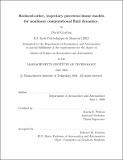| dc.contributor.advisor | Karen E. Willcox. | en_US |
| dc.contributor.author | Gratton, David, 1979- | en_US |
| dc.contributor.other | Massachusetts Institute of Technology. Dept. of Aeronautics and Astronautics. | en_US |
| dc.date.accessioned | 2005-05-17T14:49:32Z | |
| dc.date.available | 2005-05-17T14:49:32Z | |
| dc.date.copyright | 2004 | en_US |
| dc.date.issued | 2004 | en_US |
| dc.identifier.uri | http://hdl.handle.net/1721.1/16658 | |
| dc.description | Thesis (S.M.)--Massachusetts Institute of Technology, Dept. of Aeronautics and Astronautics, 2004. | en_US |
| dc.description | Includes bibliographical references (p. 75-79). | en_US |
| dc.description | This electronic version was submitted by the student author. The certified thesis is available in the Institute Archives and Special Collections. | en_US |
| dc.description.abstract | Computational fluid dynamics (CFD) is now widely used throughout the fluid dynamics community and yields accurate models for problems of interest. However, due to its high computational cost, CFD is limited for some applications. Therefore, model reduction has been used to derive low-order models that replicate CFD behavior over a restricted range of inputs, and various frameworks have been developed. Unfortunately, the majority of those methods are limited to linear cases and do not properly handle reduction of nonlinear systems. In order to overcome restrictions of weak nonlinearity and the costly representation of the system's nonlinearity found in other nonlinear reduction approaches, a trajectory piecewise-linear (TPWL) scheme is developed for a CFD model of the two-dimensional Euler equations. The approach uses a weighted combination of linearized models to represent the nonlinear CFD system. Using a set of training trajectories obtained via a simulation of the nonlinear CFD model, algorithms are presented for linearization point selection and weighting of the models. Using the same training trajectories to provide a snapshot ensemble, the proper orthogonal decomposition (POD) is used to create a reduced-space basis, onto which the TPWL model is projected. This projection yields an efficient reduced-order model of the nonlinear system, which does not require the evaluation of any full-order system residuals, while capturing a large portion of the nonlinear space. The method is applied to the case of flow through an actively controlled supersonic diffuser. Convergence of the TPWL approach is presented for both full-order and reduced-order cases. | en_US |
| dc.description.abstract | (cont.) The TPWL approach and the POD combine naturally to form an efficient reduction procedure and the methodology is found to yield accurate results, including cases with significant shock motion. Reduced-order PWL models are shown to be three orders of magnitude more efficient than the nonlinear CFD for simulation of a representative test case. | en_US |
| dc.description.statementofresponsibility | by David Gratton. | en_US |
| dc.format.extent | 79 p. | en_US |
| dc.format.extent | 1137836 bytes | |
| dc.format.extent | 1186081 bytes | |
| dc.format.mimetype | application/pdf | |
| dc.format.mimetype | application/pdf | |
| dc.language.iso | eng | en_US |
| dc.publisher | Massachusetts Institute of Technology | en_US |
| dc.rights | M.I.T. theses are protected by copyright. They may be viewed from this source for any purpose, but reproduction or distribution in any format is prohibited without written permission. See provided URL for inquiries about permission. | en_US |
| dc.rights.uri | http://dspace.mit.edu/handle/1721.1/7582 | |
| dc.subject | Aeronautics and Astronautics. | en_US |
| dc.title | Reduced-order, trajectory piecewise-linear models for nonlinear computational fluid dynamics | en_US |
| dc.title.alternative | Reduced-order, TPWL models for nonlinear CFD | en_US |
| dc.type | Thesis | en_US |
| dc.description.degree | S.M. | en_US |
| dc.contributor.department | Massachusetts Institute of Technology. Department of Aeronautics and Astronautics | |
| dc.identifier.oclc | 56528451 | en_US |
